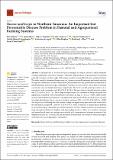| dc.description.abstract | Coenurosis due to Taenia multiceps has emerged as a major concern to small ruminant-
owning communities in northern Tanzania. Although a high incidence of disease has been reported,
gaps still remain in our knowledge of the disease problem across different agro-ecological settings.
The study aimed to determine the prevalence of coenurosis in small ruminants and taeniid infection
in dogs and identify risk factors for infection. Questionnaire surveys, postmortem examination of
small ruminants, and coproscopic examination of dog faeces were used to collect data on reported
coenurosis cases and taeniid infections, respectively. The twelve-month period prevalence of co-
enurosis in small ruminants was 8.4% (95% CI 8.2–8.6). The prevalence of taeniid infection in dogs
was 12.5% (95% CI 9.1–17.4). The village-level prevalence of coenurosis in sheep and goats was
significantly correlated with taeniid infection prevalence in dogs (r = 0.51, p = 0.029). Multivariable
analysis indicated that home slaughter was significantly associated with the livestock owner-reported
neurological syndrome due to coenurosis in sheep and goats (OR = 13.3, 95% CI 4.2–42.0, p < 0.001)
and the practice of offering discarded brains to dogs was significantly associated with taeniid infec-
tion prevalence in dogs (OR = 2.80, 95% CI 0.98–7.98, p = 0.05). Coenurosis is a major disease problem
in livestock-keeping communities of northern Tanzania, but there is little awareness of transmission
risks associated with home slaughter and dog feeding practices. There is a need for veterinary
and animal health services to engage more actively with communities to increase awareness of the
transmission cycle of T. multiceps and the preventive measures that can be taken to reduce the impact
of disease in livestock-dependent communities. | en_US |

